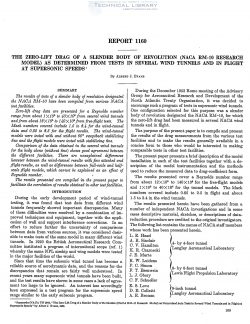naca-report-1160
- Version
- 171 Downloads
- 1.38 MB File Size
- 1 File Count
- November 2, 2016 Create Date
- November 2, 2016 Last Updated
National Advisory Committee for Aeronautics, Report - The Zero Lift Drag of a Slender Body of Revolution (NACA RM-10 Research Model) as Determined from Tests in Several Wind Tunnels and in Flight at Supersonic Speeds

The results of tests of a slender body of revolution designated
the NACA RM—IO have been compiled from various NAC'A
test facilities.
Zero-lift drag data are presented for a Reynolds number
range from about 1X10o to 40X10° from several wind tunnels
and from about 12X10‘3 to 140x10°fromfree-flight tests. The
Mach numbers covered include 1.5 to 2.4 for the wind—tunnel
data and 0.85 to 2.5 for the flight results. The wind—tunnel
models were tested with and without 60° sweptbaclc stabilizing
tins and the flight models were tested with stabilizing tins.
Comparison of the data obtained in the several wind tunnels
for the body alone (without fins) shows good agreement between
the dizferent facilities. There are unexplained difi'erences
however between the wind-tunnel results with flns attached and
flight results, as well as difierences between full-scale and half-
scale flight models, which cannot be explained as an effect of
Reynolds number.
The results presented are compiled in the present paper to
facilitate the correlation of results obtained in other test facilities.
During the early development period of wind-tunnel
testing, it was found that test data from different wind
tunnels frequently showed important discrepancies. Many
of these difficulties were resolved by a combination of im-
proved techniques and equipment, together with the appli-
cation of wall and support interference corrections. In an
effort to reduce further the uncertainty of comparisons
between data from various sources, it was considered desir-
able to make tests of the same model in many different Wind
tunnels. In 1920 the British Aeronautical Research Com-
mittee instituted a program of international scope (ref. 1)
whereby the same NPL airship and Wing models were tested
in the major facilities of the world.
| File | Action |
|---|---|
| naca-report-1160 The Zero Lift Drag of a Slender Body of Revolution (NACA RM-10 Research Model) as Determined from Tests in Several Wind Tunnels and in Flight at Supersonic.pdf | Download |

Comment On This Post